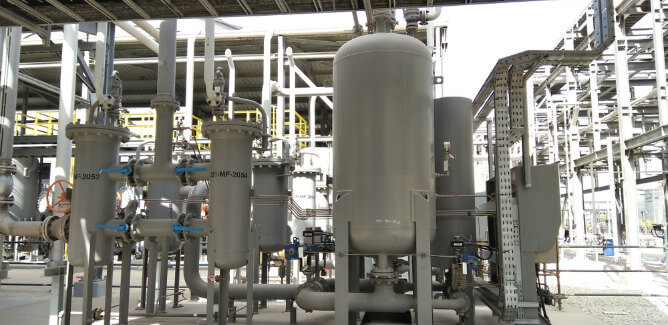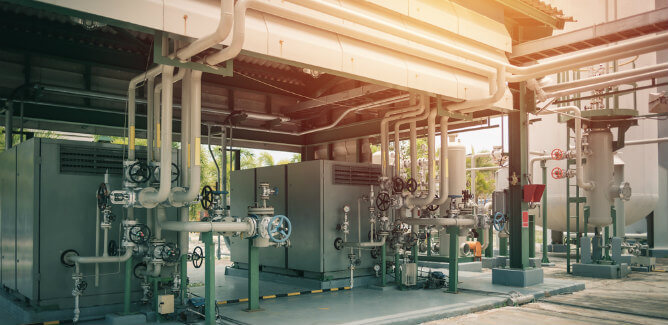
Industrial Compressed Air System Design & Piping Layout
The industrial applications of compressed air range from food processing to beverage production to operations in natural gas recovery and transport. Considering the indispensable nature of compressed air to the success of various manufacturing processes, it’s vital that it meets the required usage specifications.
The key to achieving the supply of high quality compressed air is the creation and implementation of an optimized compressed air system plan. This article will consider the various aspects of the design and piping layout required to properly produce and transport compressed air free of impurities.
How to Lay Out Compressed Air Piping System
The effectiveness of an air compressor system is determined by how its components are installed. To gain optimal efficiency, system operators need to consider various installation variables and avoid common mistakes which hinder satisfactory process performance.
Critical Factors for Your Industrial Compressed Air System Design
Plumbing a compressed air system requires engineers to consider the four vital factors listed below:
- Elevated levels of water vapor/moisture
- Acute piping angles
- Obstructions to compressed airflow
- Piping material choices
Neglecting to pay attention to these factors will cause a significant drop in the efficiency of a finished air system.
Water Vapor/Moisture
During the compression of air, the generation of water vapor is an unavoidable by-product. The moisture originates from the water in the ambient air used as the raw material for producing the compressed air.
Excess moisture will damage some types of pipes as it hastens the onset of corrosion. Further, rusting pipes will form oxides that will break off from the pipe walls into the circulating compressed air, leading to clogging. Overall, there will be a drop in the efficiency of the system.
Effective measures to eliminate moisture from compressed air lines include the use of drying towers, air cooling devices, and moisture filters. These methods will pull water moisture out of the compressed air system and protect its components from deterioration.
Check out NiGen’s desiccant air dryer rentals for help with your compressed air drying needs today!
Acute Piping Angles
The presence of acute bends in the piping of a compressed air system slows the velocity of flow and therefore diminishes the pressure of supplied air. Air flowing through these sharp bends will experience turbulent flow which cuts down the rate of fluid flow, therefore requiring the compressor to work extra hard to compensate for the pressure being bled from the system.
Minimizing the amount of turbulence within air compressor plumbing can be achieved by the installation of gentler piping bends. Turns between 30 to 45 degrees will enable operators to attain maximal efficiency.
Obstructions to Compressed Airflow
Occlusion of the lumen of a compressor pipe can occur following corrosion of its walls as well as the accumulation of other particulate impurities. An obstruction in the flow within an air compressor line setup can be detected as variation in pressure readings at various points in the piping. A high-pressure reading will be obtained before the obstruction while a much lower reading will result downstream of the occlusion.
Overcoming issues of obstruction will require the installation of air filters and the regular maintenance of the compressor piping.
Piping Material Choices
Various materials can be utilized in constructing air compressor piping. In most cases, the pipes are made of metal or plastic polymers. While individual operator preferences differ, each pipe material has its pros and cons in terms of performance and durability.
Plastic Piping
The use of plastic as an air compressor’s piping material confers several benefits compared to its metallic counterparts. Plastic pipes are lighter, do not corrode when exposed to moisture and can be dismantled and refitted using basic repair tools.
For optimal efficiency, the compressor pipe is made from special plastic polymers most commonly polyvinyl chloride or its chlorinated variant. Other effective plastics suitable for an air compressor piping setup are acrylonitrile butadiene styrene (ABS) and polyethylene in its high-density form.

Typical Compressed Air System Layout Mistakes
When planning a pneumatic piping system design, engineers may overlook some vital details that will significantly affect overall process efficiency. The most common forms of compressed air pipe design setup errors are discussed below.
Small Flow Line Installation
A common air piping design error which compressor line engineers make is selecting flow lines which are too small to handle the amount of pressure generated by the air compression process. Choosing the wrong size of pipes will lead to rapid deterioration and raise maintenance costs.
Inappropriate Air Compression Unit Size
Properly sizing compressed air systems is vital to generating maximal output. The installation of an undersized compressor unit will cause a rapid system failure. To avoid costly process downtime, the right compressor should be installed in a pneumatic setup.
If you need compressed air in a pinch, check out NiGen’s industrial air compressor rentals today.
Inadequate Storage
Sizing compressed air piping systems involves taking appropriate storage component dimensions. A lack of sufficient storage space will hinder the ability of the compressed air system to meet supply requirements.
Poor Airflow Routing
Instrument air piping flow design should discourage the installation of sharp turns and junctions. The use of 30 to 45 degree turns is more suitable for conducting compressed air compared to 90-degree bends which generate turbulent fluid flow and bleed off about 3 to 5 psi of pressure per turn.
Trust NiGen for Your Compressed Air Needs
In over two decades of existence, NiGen has offered the most innovative solutions for the oil and gas industry. We offer industrial air compressors rentals which are suitable for use in a wide range of industrial processes.
If you’d like to learn more about our products and services, please contact us online today!
